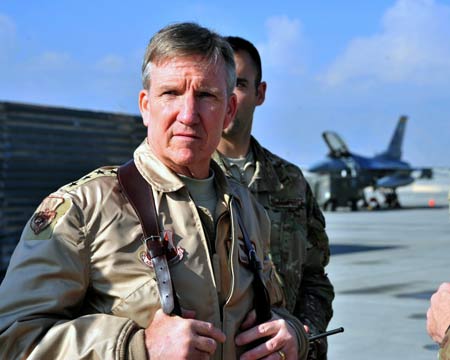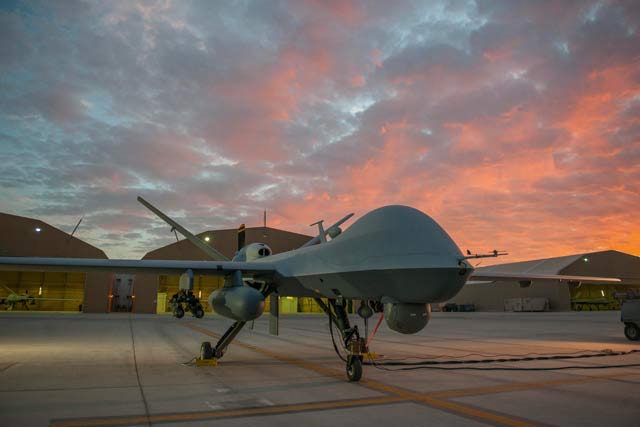After nearly 40 years in the US Air Force, Gen Herbert “Hawk” Carlisle will hand over the reins of Air Combat Command on 10 March to his successor, Lt Gen Mike Holmes.
For more than two years Carlisle has presided over the 1,300 aircraft within ACC that meet the USAF’s strategic air defence needs. The diverse portfolio under his purview includes the Lockheed Martin F-22, General Atomics Aeronautical Systems MQ-9 Reaper, Northrop Grumman RQ-4 Global Hawk, and Northrop E-8C Joint Surveillance Target Attack Radar System. Then there is the Fairchild Republic A-10: the close air support jet that has emerged as both a darling of aviation enthusiasts and a fiscal headache for the air force.
Yet Carlisle’s legacy in his last post may be cemented by the Lockheed F-35A Lightning II, which reached limited combat capability last August. He tempered his tone during the announcement of that milestone, saying the aircraft still required significant work that would come with impending software and hardware upgrades.
As Carlisle heads into retirement this spring, it would appear he is counting the F-35 not as an embattled programme, but a work in progress. That position does not jibe with the Pentagon’s outgoing senior weapons tester, Michael Gilmore, who penned several caustic assessments of the fighter programme over his tenure. In his last report, Gilmore warned that hundreds of deficiencies on the platform would push full combat tests to late 2018 or early 2019; more than a year after the planned date.
In an August report following the F-35A’s initial operational capability announcement, Gilmore wrote that with the current Block 3i software, the aircraft might be less effective in a permissive environment than many “fourth-generation” platforms, including the A-10. With Block 3i software, the F-35A lacks an automated targeting capability for tracking and targeting moving vehicles: a feature that legacy platforms already have.
During a January exit interview with FlightGlobal, Carlisle acknowledged that individual capabilities on the F-35, such as its electro-optical targeting system (EOTS), needed work and would improve with Block 4 upgrades. But he also argues that taken as a whole, the new type will outperform legacy aircraft.

US Air Force
“In some cases, the [EOTS] we’re fielding on the F-35 are not as good as the current pods that are mounted externally on current aircraft,” he says. “And you can take things individually like that, but the airplane deploys as a package. In many environments, the A-10 can’t get close enough to employ anything because it’s threatened at a level that the F-35 is not.”
The USAF already knew about some of the gaps Gilmore pointed out and understood that those capabilities would not be available in the early Block 3i variant, Carlisle adds.
“Some of the things he talked about, it was planned that way,” he says. “The one counter-argument I would make to Gilmore is, every developmental programme goes through this. These are incredibly complex machines and you continue to improve the capability as you go.”
With all of the F-35’s technical issues aside, the fifth-generation aircraft will still fly with fourth-generation missiles. Lockheed designed it to accommodate Raytheon’s AIM-120 AMRAAM, but Carlisle wants a combination air-to-air and air-to-ground missile that can offer greater range for the aircraft.
“Range is a big factor if you look at our potential adversaries with things like the [Chinese] PL-15,” he says. “I think it needs to be multiband, broad spectrum – which aids it in survivability and reaching the target.”
Carlisle sees the missile fielded across a spectrum of platforms, from fourth-generation aircraft to a future penetrating counterair platform and Northrop’s B-21 bomber. He also believes technology will enable the USAF to achieve greater range within the current size and configuration for the F-35.
“I can’t comment a lot on where we’re going to go with what we’re developing on technology, but I will tell you that we worked hard,” he says. “I think with the engine and motor technology for weapons we can get range, depending on what kind of profile and motor we use.”
Even as the F-35 continues to face numerous hurdles, Carlisle is set on increasing the buy rate for the aircraft. In that endeavour, he could find an unlikely ally in Congress: the Senate Armed Services Committee chairman John McCain. The Republican senator has long stood as one of the programme’s harshest critics, but his recent recommendations for the defence budget vouches for an increased acquisition of F-35As.
Current funding constraints have forced the USAF to procure 228 F-35As between fiscal years 2018 and 2022, at a rate of 48 aircraft per year. That means the service would not reach its goal of 1,763 F-35As until 2040, according to McCain’s recent white paper. While the senator did not state a number, he argues that the USAF should buy as many F-35s as possible over the next five years.
“My objective is to increase the buy rate as much as I can for as long as I can,” Carlisle says. “I would love to get to 60. I’d love to get to 80 a year in the [conventional take-off and landing] version, which was the plan we had a while ago. We were just never able to finance it.”
The F-35 procurement is not the only casualty of a more austere Pentagon. Carlisle is leaving an air force that has pushed many of its budget priorities to the right. Since sequestration and the budget control act of 2011, the Department of Defense has tightened its belt. That has often forced the services to choose between pursuing ambitious modernisation programmes and maintaining their current fleets.
Despite characterising the ACC’s JSTARS capability as a high-priority item, recapitalisation of the battle management, command and control platform has lagged for several years. The air force had mulled moving the effort to a rapid capability office, but decided against it. Instead, the service will continue the programme on its current path – but may consider incorporating elements of rapid acquisition that could push the replacement along. Another E-model jet platform, the Boeing E-3 airborne warning and control system (AWACS), will not see recapitalisation until the mid-2020s.
The USAF also has its eye on an MQ-9 Reaper follow-on, but there is no room in near-term budgets for MQ-X, Carlisle says. The service does not have a final answer on its MQ-X acquisition plan, but his recent meetings with USAF chief of staff Gen David Goldfein indicate the air force will continue buying MQ-9s longer than previously planned. Still, the current system is in need of a modernisation overhaul, he adds. Since the unmanned air vehicle was developed in 1996, it has not returned home to undergo a routine modernisation.
“I think the MQ-X is something we need to get after,” he says. “We need open mission systems, we need a little bit of a different concept of operation, because the MQ-9 enterprise is a very manpower intensive enterprise.”
Meanwhile, discussions over which platform will succeed the Cold-War era Lockheed U-2 have all but fallen off the air force’s radar. In 2015, Lockheed unveiled an optionally piloted, next-generation U-2 at the annual Air Force Association conference. At the time, the USAF shrugged off the company’s advances, and months later recommended designing an unmanned platform. Although the USAF is checking out different avenues to fill that high-altitude intelligence, surveillance and reconnaissance void, a next-generation U-2 is not a top concern in the budget today, Carlisle says.
One potential budget item that has stirred much discussion in Washington DC involves a low-cost fighter jet. The prospect of a low-end strike asset crops up every few years within the air force, sometimes even garnering a request for information from the service. But the concept is often quashed by a change of command, administration or budget priorities.
The latest iteration of this concept is OA-X, a low-cost close air support platform that would be designed for use in permissive environments. That could prove a cheap and attractive option for the air force’s counterinsurgency operations in Iraq, Afghanistan and even Syria. The USAF gave OA-X some credence in 2016 when it announced an experiment slated for early this year that would consider low-cost fighter options.
That experiment could also test whether lighter attack aircraft could handle the major ordnance available on the A-10: namely the 30mm GAU-8/A seven-barrel Gatling gun. Carlisle names BAE Systems’ 70mm Advanced Precision Kill Weapon System guided rocket as one contender for a light aircraft.
“I think for some of these aircraft the GAU-8 would be a challenge,” he says. “But maybe there’s ordnance out there that aren’t the GAU-8, but can do a lot of that mission and can fulfil the capability.”

Service will buy MQ-9 Reapers for longer than previously planned
US Air Force
Carlisle sees OA-X moving forward this time, saying the aircraft could bear budget and operational advantages. The service could procure such aircraft cheaply, and their operation and maintenance costs would come in lower than for current platforms, he says. Foreign partners could also buy into the programme, although Carlisle notes that peer allies such as Australia, France and the UK have not expressed an interest in a light attack platform. Carlisle, who left the US Pacific Command in 2014, adds that OA-X could also prove a tough sell for South Korea, which faces a more contested environment.
“Having said that, I think we have to balance those positives with the threat environments that are increasing,” he says. “If you look at what we’re doing with Inherent Resolve [the operation in Syria and Iraq] today, I will tell you those threats are getting more challenging, not less. Then the other thing is, if we spend the money on that, what aren’t we spending the money on? There’s other priorities that fit into the budget.”
McCain and Carlisle could find common ground on OA-X as well. In his white paper, McCain recommended buying 300 light attack fighters with minimal development, and called on the USAF to buy the first 200 examples by FY2022. The high-low mix of additional F-35s plus OA-X aircraft could help Carlisle ameliorate his command’s capacity issue, he says.
“One of my biggest problems today is capacity. I just don’t have enough fighter squadrons to do everything that is being asked of me,” he says. “As we look at 300 low-end fighters, that may be something that meets the combatant commander’s need and may be one of the driving factors as we move forward and watch this test develop.”
Source: FlightGlobal.com



















